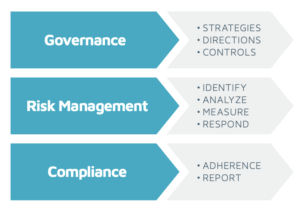Procurement and Risk: What You Need to Know
This is the first in a four-part series for Procurement teams on how to automate compliance while reducing cycles, increasing savings, and boosting collaborative efforts.
It’s no secret. Organizations are dealing with a challenging business climate. They lose millions due to lack of visibility and pay hefty fines resulting from the inability to keep up with an ever-increasing pace of business. Rising levels of uncertainty within our global economy have resulted in an alarming amount of potential pitfalls for incumbents and newcomers alike. This means risk management, current and future, has never been more of a top priority. However, Procurement has a secret weapon—contracts.
Touching every business process and every department, contracts, and the processes surrounding them, are the critical lynchpin to being able to plan for, mitigate, and manage risk.
This four-part series shows Procurement teams how to automate compliance, while reducing cycles, increasing savings, and boosting collaborative efforts. Each part covers methods that solve for both immediate and future risk that will enable faster processes, increased efficiency, and accelerated growth not just within the Procurement department but the organization as a whole.
Procurement and Risk
The role of Procurement has changed dramatically. Procurement has been recognized, and rightly so, as a fundamental business enabler and strategic function, especially among forward-thinking organizations. The Procurement department, now a key partner in business planning and performance, is tasked with achieving sustainable cost reduction and reducing risk, while enabling agility. Considering the current hyper-competitive and fluctuating state of global business, the question procurement contracts should be looking to answer is, how do you move fast while also remaining compliant?
Risk and compliance have been “managed” for a long time. Organizations have developed a slew of departments and programs—performance management programs, risk management programs, compliance programs, corporate social responsibility programs, and so on. Unfortunately, these departments and programs are often siloed and ineffective, resulting in counterproductive objectives and sub-optimal outcomes, including drawbacks:
- High costs
- Lack of visibility into risks
- Inability to address third-party risks
- Inability or difficulty measuring risk-adjusted performance
- Negative surprises
There’s another way.
Theodore Roosevelt said, “Risk is like fire: If controlled, it will help you; if uncontrolled, it will rise up and destroy you.”
The top three methods to manage increasing demands are 1) increasing the use of technology; 2) reengineering work processes; and 3) commoditization or automation of routine tasks. All of these involve enhancements to process and technology. The “department of no” can be the “department of yes,” enabling others and driving business forward. All that’s needed is a modern approach.
A new, old method.
Establishing an approach that ensures the right people get the appropriate and correct information at the right times, that the right objectives are established, and that the right actions and controls necessary to address uncertainty and act with integrity are put in place is paramount. But how?
OCEG has an interesting take on the next steps. Principled Performance is a method they define as “an approach to business that helps organizations reliably achieve objectives, address uncertainty, and act with integrity.” GRC, sparked by the famous ‘Sarbanes-Oxley Act (SOX)’ highlights the three stages or areas of focus when it comes to comprehensive risk management.

This three-pronged approach creates a comprehensive, integrated method of dealing with risk, and the single most effective way to attain it is through your contracts and contract management processes.
Next week, we’ll discuss achieving risk and compliance maturity through contracts.
Want to see how you can reduce your risk?



